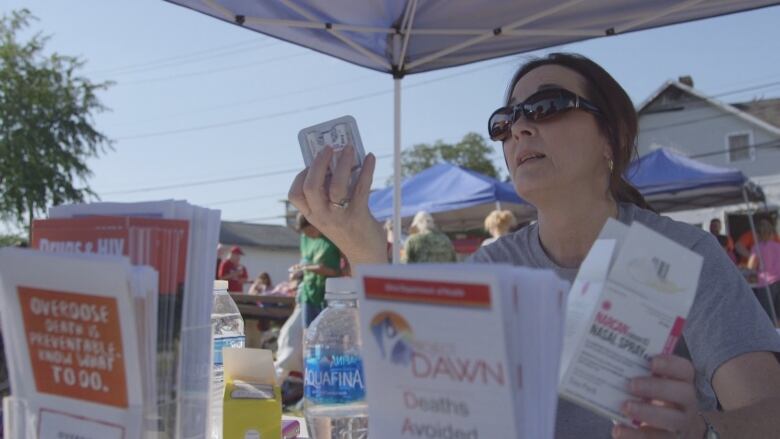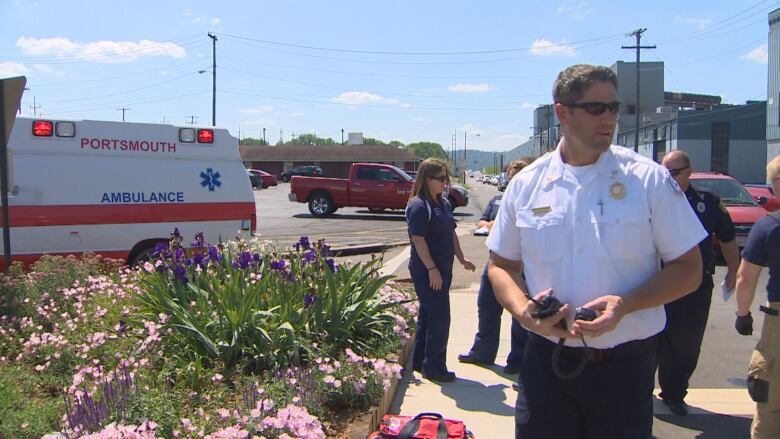'Our new normal': Hard-hit Ohio community fears opioid overdoses will be perpetual crisis
'This is a problem that we're going to have to live with for a very long time maybe forever'

The numbers are crushing: an estimated 4,149 people in Ohio died from unintentional drug overdoses last year up 36 per cent over 2015.
Consider that fewer people live in Ohio than Canada's largest province of Ontario, yet its number of fatal overdoses is nearly double that of our country's already-staggering 2,458 fatalities in 2016.
Ohio has been one of the hardest hit by North America's growing opioid crisis a state that already led the U.S. in the total number of fatal overdoses in both 2014 and 2015.
Last year's increase has been blamed on heroin, as well as the powerful synthetic opioids fentanyl and carfentanil.
Those disquieting statistics are cited in a recent statement of claim filed by the state against the manufacturers of a number of painkillers. Ohio is suing the drugmakers, accusing the pharmaceutical industry of aiding the opioid epidemic by misleading doctors and patients about the danger of addiction.
The epidemic is especially palpable in the southern part of Ohio, where economic despair has exacerbated years of chronic drug abuse.
In the small city of Portsmouth, the number of people admitted to hospital with a drug overdose has so far this year increased fourfold over 2016. But in this community, more are surviving.

Up until 2013, Portsmouth and the surrounding Scioto Country had the highest overdose death rate in the state.
That same year, the city launched Project DAWN, or Deaths Avoided with Naloxone, the first campaign in Ohio to get 3,200 units of the anti-overdose treatment naloxone into the hands of users and others vulnerable to drug abuse.
My fear is that this is going to be our new normal and we will continue to spiral into a Walking Dead kind of thing.- Lisa Roberts, public health nurse
Lisa Roberts, the public health nurse leading Project DAWN, said the program has reversed some 420 overdoses at the hands of non-emergency people.
But now, she said, "illicit fentanyl is undoing all of our progress."
Like many in Portsmouth, opioid abuse infiltrated Roberts' life about a decade ago, when her then-16-year-old daughter became addicted to the painkiller oxycodone.
While her daughter's long road to recovery has been successful, Roberts is not optimistic the region can pull away from addiction's grip, especially now with the rise of these stronger synthetic drugs.
"My fear is that this is going to be our new normal," she said. "That we're just going to be dealing with this forever and ever, and we will continue to spiral into a Walking Dead kind of thing."
Naloxone not working
More than half of the emergency calls that come into the Portsmouth Fire Department are for drug overdoses. The increasing potency of street drugs in the community is unlike anything they've seen before, said assistant fire Chief Chris Lowery.
"At first, we would show up on scene, and the Narcan [the brand name of naloxone] that we used would bring them out pretty easily. But now we're seeing this stuff is laced with fentanyl, other things, and it's getting harder and harder to bring them out."

Lowery grew up in Portsmouth and lost friends to the first wave of the opioid epidemic that began with prescription oxycodone two decades ago.
An imposing figure, Lowery has flown helicopters in Iraq for the U.S. army; he looks and sounds like a soldier. But as the assistant fire chief, he's fighting a different kind of battle at home that is increasingly feeling like a surrender.
"I mean, literally, as we walk up to the house, they ask us to let them go. 'Why are you messing with him? Let him die. Let him die.'
"I can't tell you how many times we get that and it's getting worse."
- Interactive map of overdose deaths brings opioid crisis to your doorstep
- How 1 paragraph helped drive an opioid epidemic
In this city of 20,000, Roberts conservatively estimates that at least 10 per cent of its citizens are opioid users, but cautions that number could be higher.
Despite the proliferation of drug treatment centres in the area, the programs offered are based on abstinence, she said, which have lower success rates than harm reduction treatment.
"We have no access to methadone in Scioto County, unless our people who are poor and some of them don't even have vehicles can drive to a methadone clinic, which is 65 miles away," she said. "But that's not realistic."
The tight restrictions on methadone is a symptom of the country's war on drugs, Roberts said, which she describes as still "alive and well in the U.S." Resistance to harm-reduction policies in southern Ohio is "astronomical," she adds.
Families torn apart by addiction
Located on the Ohio River, Portsmouth once bustled with shipping and manufacturing; it even had its own NFL team. But the population peaked as the Second World War was ending, and industry began moving away. Today, it has half the inhabitants it did in the 1930s.
The opioid crisis has further ripped at the seams that held together the social fabric of southern Ohio, where traditional Appalachian families have long been the pillars of society.
A recent report found that approximately 10 per cent of babies in the region tested positive at birth for neonatal abstinence syndrome, a form of opioid dependency.
Many of those babies end up being taken from their mothers: 70 per cent of the infants placed in the state's foster care system are children of opioid-addicted parents.
Families broken up by addiction are putting an unprecedented strain on that system.

Clint Askew, 34, is someone who is helping to pick up those pieces. He helped raise the children of his girlfriend's sister, who was serving a prison sentence for drug-related offences. Now he has a daughter of his own.
Growing up, Askew's friends and family members regularly abused prescription drugs. Now he said he continues to be confronted every day by evidence of family collapse.
"The other day, [there was] a little girl on Hilltop," he said, referring to one of the city's neighbourhoods. "Her mom and dad are in prison, so she goes home to her grandparents [they] overdosed."
Askew, a retail clerk and hip-hop artist, has chronicled his experiences in rhyme. His group, Raw Word Revival, enjoyed a local hit with What the Hell You Know About That 740?, a reference to the city's area code.
In the face of the poverty and addiction, Askew said he hopes his work contributes something positive to the community.
"So many people don't have anything to live for here. They don't really love anybody. It's easy to fall victim [to drug use] ... There's no answer for it."
It's a feeling that Roberts shares.
"This is a problem that we're going to have to live with for a very long time," she said. "Maybe forever."












_(720p).jpg)


 OFFICIAL HD MUSIC VIDEO.jpg)
.jpg)



























































































